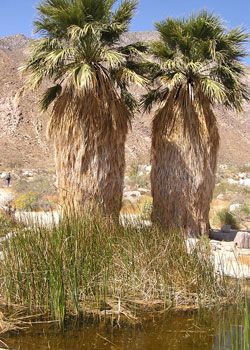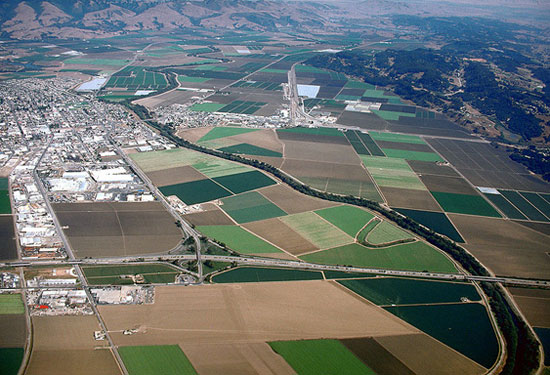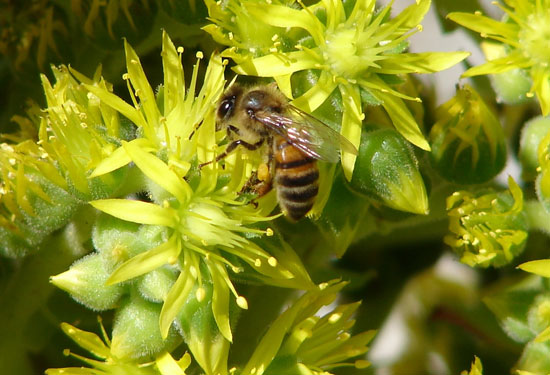« Prev Next »


In many terrestrial systems, patchiness involves spatial variation in topography, bedrock, soils, nutrients, or water that affects distribution of plant species, which at least partially determines animal distributions. For example, cattails only grow in places where the soil is saturated, such as along the margins of freshwater wetlands. In marine or freshwater systems, patchiness in species distributions may be the result of variation in substrate type, water depth, or period of inundation, for example. Natural disturbances, including fires, floods, disease outbreaks, wind storms, and wave action also create patchiness, by altering the structure of populations, communities, and ecosystems and causing changes in resource availability or the physical environment. And species may generate their own patches, independent of any underlying environmental heterogeneity, by their clumped dispersal patterns (often referred to as spatial pattern formation).
Ecologists have a long history of observing and studying the underlying causes of patchiness. Concepts and methods from landscape ecology, which focus specifically on causes and consequences of spatial heterogeneity for ecological processes, have converged with research efforts in population and community ecology, to create the recognized area of study called spatial ecology. Of relevance to biological conservation, most contemporary studies of habitat patchiness emphasize patterns and outcomes of human-caused landscape heterogeneity (Figure 2) rather than naturally occurring patterns and processes. It is important to recognize that in most, if not all landscapes, natural patchiness and human activities interact to create the spatial patterns that we see.
Definition and Scope of Spatial Ecology
In 1994, the well-known ecologist Peter Kareiva introduced a special feature in the journal Ecology with the provocative title, “Space: the final frontier for ecological theory.” This was clearly homage to the great science fiction writer Gene Rodenberry, creator of the now-classic TV series, Star Trek. But was Kareiva really talking about space, as in the domain of galaxies, nebulae and black holes? No. Ecologists weren’t ready to colonize space just yet. Instead, Kareiva’s title was a call to ecologists to recognize and incorporate understanding of spatial patterns and processes into ecological research. This explicit emphasis on spatial ecology emerged from an active convergence of research efforts in landscape ecology and population and community ecology in recent decades.

Spatial ecology centers on how specific spatial arrangements of organisms, populations, and landscapes influences ecological dynamics. In particular, much of spatial ecology is closely related to conservation biology because it emphasizes the study of habitat loss and fragmentation caused by human activities (Figure 2). The study of habitat loss and fragmentation provides an important synthesis for the entire field of ecology, because it unites fundamental ecological theories and concepts with an extensive body of empirical literature. It also provides important links to environmental applications, including conservation, restoration, and planning. There are literally thousands of papers that have been published in the past 40 years on the ecology of fragmented landscapes.
Spatial Ecological Theory
Several key ecological theories contribute to spatial ecology and guide empirical investigations in the field and laboratory. Ecologists have used these theories to develop and refine our understanding of the implications of spatial variation for ecological processes. For example, the basic notion of species-area curves reveals that as the size of a natural area increases, the number of species in that area increases as well. Because species richness is so tightly linked to habitat area, it is not surprising that the major reason for species decline in the past fifty years is because rates of habitat loss are unprecedented. The theory of island biogeography predicts that larger and less isolated islands will contain more species than smaller, more isolated islands. Metapopulation theory recognizes that local populations of organisms undergo periodic colonization and extinction, but that these local populations are linked to other populations nearby by migration. Hence, the collection of local populations, termed the metapopulation, can persist indefinitely if rates of local population extinction are balanced by rates of colonization from surrounding populations.
Recent elaborations of metacommunity theory are particularly relevant to understanding species interactions in fragmented landscapes. Metacommunity ecology is essentially an extension of metapopulation theory — but instead of single species populations blinking in and out of scattered habitat patches, we now have multiple species that occur and interact across patchy landscapes. A metacommunity is broadly defined as a collection of communities connected by dispersal. Studies in metacommunity ecology seek to understand how habitat patchiness structures species interactions.
Effects of Spatial Variation on Species and Ecosystems
Research in spatial ecology reveals that populations and communities often suffer declines or changes in composition as a result of reductions in fragment area and connectivity. This is frequently because in fragmented landscapes, species often encounter obstacles in their attempts to travel safely from one suitable patch to another. Because some species avoid certain landscape features, such as parking lots or cornfields, habitat loss and fragmentation may force species to navigate through complex patchworks of suitable habitat, ultimately reducing their success.
Relevance of Spatial Ecology to Conservation
Habitat loss and fragmentation constitute the most serious threats to Earth’s biological diversity, and understanding their consequences for persistence of native populations and communities remains a daunting challenge for conservation biologists. Two particularly relevant species interactions that may be altered as a result of habitat loss and fragmentation serve to illustrate critical links between spatial ecology and conservation. In both of these examples, human manipulation of the spatial arrangement of land cover and land uses has affected the ways in which species interact with one another.
First, a vital ecological interaction for plants is the mutualistic relationship between plants and their pollinators (Figure 3), which may also be affected by a variety of mechanisms that stem from changes in habitat spatial characteristics. Studies of agricultural landscapes in California, for example, have shown that the abundance and diversity of native pollinators, and their contribution to pollination, is strongly influenced by spatial characteristics of the landscape. Specifically, farms that are surrounded by a relatively high proportion of natural habitat (30% or more cover the native habitat within 1 km of the farm) enjoy higher pollen deposition on watermelon flowers than farms surrounded by a low cover of native habitat (less than 1% within 1 km of the farm). The patches of native habitat provide critical nesting and foraging habitat for native bees, so the abundance and diversity of bees is higher at these farms.

Second, the transmission and spread of infectious diseases is largely a function of interactions within and among species within ecological communities. Recent research reveals that losses of biological diversity caused by habitat loss and fragmentation may increase the risk of several well-known, vector-borne diseases that are shared between humans and wildlife. For example, recent increases in human incidence of malaria, Lyme disease, and West Nile virus are all associated with declines in species richness caused by landscape change. In these cases, habitat loss and fragmentation have reduced the abundance and richness of predators and competitors from ecological communities, causing an increased abundance of competent host species and thus increased pathogen prevalence. There is a clear warning that, as we reduce biological diversity, we are compromising the ability of natural systems to dilute pathogens, as well as increasing our own exposure to infectious diseases.
Conclusions and Future Directions in Spatial Ecology
The study of spatial ecology provides a critical venue for students and practitioners to apply this knowledge toward efforts to protect and re-assemble natural ecosystems, thereby maintaining both species and ecosystem services. By merging our understanding of broad-scale habitat modification with responses of populations, species, and communities to these landscape changes, spatial ecologists will be better positioned to predict and resolve the consequences of landscape change for native biological diversity. The field of spatial ecology is rich and rewarding, with exciting opportunities to link rigorous ecological theory with applications to conservation of biological diversity and ecosystem services.
References and Recommended Reading
Chase, J. M. Towards a really unified theory for metacommunities. Functional Ecology 19, 182–186 (2005).
Collinge, S. K. Ecology of Fragmented Landscapes. Baltimore, MD: Johns Hopkins University Press, 2009.
Delcourt, H. R., Delcourt, P. A. et al. Dynamic plant ecology: the spectrum of vegetational change in space and time. Quaternary Science Reviews 1, 153–175 (1983).
Forman, R. T. T. & Godron, M. Landscape ecology. New York, NY: Wiley, 1986.
Foster, D. R., Fluet, M. et al. Human or natural disturbance: landscape-scale dynamics of the tropical forests of Puerto Rico. Ecological Applications 9, 555–572 (1999).
Hanski, I. & Gilpin, M. E. eds. Metapopulation Biology. San Diego, CA: Academic Press, 1997.
Holyoak, M., Leibold, M. A. et al. eds. Metacommunities: Spatial Dynamics and Ecological Communities. Chicago, IL: University of Chicago Press, 2005.
Jules, E. S. & Shahani, P. A broader ecological context to habitat fragmentation: why matrix habitat is more important than we thought. Journal of Vegetation Science 14, 459–464 (2003).
Kremen, C., Williams, N. M. et al. Crop pollination from native bees at risk from agricultural intensification. Proceedings of the National Academy of Sciences 99, 16812-16816 (2002).
Leibold, M. A., Holyoak, M. et al. The metacommunity concept: a framework for multi-scale community ecology. Ecology Letters 7, 601–613 (2005).
Levin, S. A. & Paine, R. T. Disturbance, patch formation and community structure. Proceedings of the National Academy of Sciences 71, 2744–2747 (1974).
Pickett, S. T. A. & White, P. S. The ecology of natural disturbance and patch dynamics. New York, NY: Academic Press, 1985.
Tilman, D. & Kariava, P. eds. Spatial ecology: the role of space in population dynamics and interspecific interactions. Princeton, NJ: Princeton University Press, 1997.
Turner, M. G. ed. Landscape heterogeneity and disturbance. New York, NY: Springer-Verlag, 1987.
Turner, M. G. Landscape ecology: the effect of pattern on process. Annual Review of Ecology and Systematics 20, 171–197 (1989).
Urban, D. L., O'Neill, R. V. et al. Landscape ecology. BioScience 37, 119–127 (1987).
Watt, A. S. Pattern and process in the plant community. Journal of Ecology 35, 1–22 (1947).
Wiens, J. A. Population responses to patchy environments. Annual Review of Ecology and Systematics 7, 81–120 (1976).
Wiens, J. A. The emerging role of patchiness in conservation biology. In The Ecological Basis of Conservation: Heterogeneity, Ecosystems, and Biodiversity. Pickett, S. T. A. & Ostfeld, R. S., et al. eds. (New York: Chapman & Hall, 1997): 93–107.
Wiens, J.A., Moss, M. R. et al. eds. Foundation papers in landscape ecology. New York, NY: Columbia University Press, 2006.





























